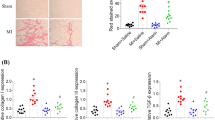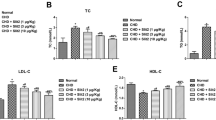Abstract
Increased NADPH oxidase activity is found in both experimental and clinical HF. Here, we investigated the effects and mechanisms of NADPH oxidase inhibition on cardiac function in rabbits with HF. HF was induced by combined volume and pressure overload. Rabbits with HF or sham operation were randomized to orally receive apocynin, an inhibitor of NADPH oxidase (15 mg per day) or placebo for 8 weeks. Echocardiography was performed to examine the cardiac function and structure of the rabbits. Cardiac fibrosis was evaluated by masson’s trichrome staining. The transforming growth factor-beta (TGF-β), connective tissue growth factor (CTGF), matrix metalloproteinase-2 (MMP-2), and matrix metalloproteinase-9 (MMP-9) expression were measured by real-time PCR. The expression of SERCA2a and phospholamban (PLB) was detected by reverse transcription-polymerase chain reaction and Western Blot. SERCA2a activity was evaluated by measuring the Pi liberated from ATP hydrolysis. Rabbits with HF exhibited cardiac dysfunction and fibrosis. These changes were associated with significant increases in myocardial NADPH oxidase activity and oxidative stress. Compared with sham-operated rabbits, the TGF-β, CTGF, MMP-2, and MMP-9 mRNA expression significantly increased, the expression of SERCA2a and PLB dramatically decreased, and the SERCA2a activity was lower in HF rabbits. Apocynin reduced NADPH oxidase activity and oxidative stress, decreased TGF-β, CTGF, MMP-2, and MMP-9 expression, attenuated cardiac fibrosis, increased SERCA2a and PLB expression, restored SERCA2a activity, and thereby ameliorated cardiac dysfunction. Thus, chronic NADPH oxidase inhibition ameliorated cardiac dysfunction by decreasing cardiac fibrosis and preserving SERCA2a expression and activity.







Similar content being viewed by others
References
Baker DW, Einstadter D, Thomas C et al (2003) Mortality trends for 23, 505 medicare patients hospitalized with heart failure in Northeast Ohio, 1991 to 1997. Am Heart J 146:258–264. doi:10.1016/S0002-8703(02)00075-3
Seddon M, Looi YH, Shah AM (2007) Oxidative stress and redox signalling in cardiac hypertrophy and heart failure. Heart 93:903–907. doi:10.1136/hrt.2005.068270
Lambeth JD (2004) NOX enzymes and the biology of reactive oxygen. Nat Rev Immunol 4:181–189. doi:10.1038/nri1312
Murdoch CE, Grieve DJ, Cave AC et al (2006) NADPH oxidase and heart failure. Curr Opin Pharmacol 6:148–153. doi:10.1016/j.coph.2005.10.008
Murdoch CE, Zhang M, Cave AC et al (2006) NADPH oxidase-dependent redox signalling in cardiac hypertrophy, remodelling and failure. Cardiovasc Res 71:208–215. doi:10.1016/j.cardiores.2006.03.016
Heymes C, Bendall JK, Ratajczak P et al (2003) Increased myocardial NADPH oxidase activity in human heart failure. J Am Coll Cardiol 41:2164–2171. doi:10.1016/S0735-1097(03)00471-6
Guo P, Nishiyama A, Rahman M et al (2006) Contribution of reactive oxygen species to the pathogenesis of left ventricular failure in Dahl salt-sensitive hypertensive rats: effects of angiotensin II blockade. J Hypertens 24:1097–1104
Qin F, Simeone M, Patel R (2007) Inhibition of NADPH oxidase reduces myocardial oxidative stress and apoptosis and improves cardiac function in heart failure after myocardial infarction. Free Radic Biol Med 43:271–281. doi:10.1016/j.freeradbiomed.2007.04.021
Sorescu D, Griendling KK (2002) Reactive oxygen species, mitochondria, and NAD(P)H oxidases in the development and progression of heart failure. Congest Heart Fail 8:132–140
Zhao W, Zhao T, Chen Y et al (2008) Oxidative stress mediates cardiac fibrosis by enhancing transforming growth factor-beta1 in hypertensive rats. Mol Cell Biochem 317:43–50. doi:10.1007/s11010-008-9803-8
Akki A, Zhang M, Murdoch C et al (2009) NADPH oxidase signaling and cardiac myocyte function. J Mol Cell Cardiol 47:15–22. doi:10.1016/j.yjmcc.2009.04.004
Ai X, Curran JW, Shannon TR et al (2005) Ca2+/calmodulin-dependent protein kinase modulates cardiac ryanodine receptor phosphorylation and sarcoplasmic reticulum Ca2+ leak in heart failure. Circ Res 97:1314–1322. doi:10.1161/01.RES.0000194329.41863.89
Frank KF, Bölck B, Erdmann E et al (2003) Sarcoplasmic reticulum Ca2+-ATPase modulates cardiac contraction and relaxation. Cardiovasc Res 57:20–27
MacLennan DH, Kranias EG (2003) Phospholamban: a crucial regulator of cardiac contractility. Nat Rev Mol Cell Biol 4:566–577. doi:10.1038/nrm1151
Armoundas AA, Rose J, Aggarwal R et al (2007) Cellular and molecular determinants of altered Ca2+ handling in the failing rabbit heart: primary defects in SR Ca2+ uptake and release mechanisms. Am J Physiol Heart Circ Physiol 292:H1607–H1618. doi:10.1152/ajpheart.00525.2006
Meyer M, Schillinger W, Pieske B et al (1995) Alterations of sarcoplasmic reticulum proteins in failing human dilated cardiomyopathy. Circulation 92:778–784
Kim SO, Merchant K, Nudelman R et al (2002) OxyR: a molecular code for redox-related signaling. Cell 109:383–396
Pogwizd SM (1995) Nonreentrant mechanisms underlying spontaneous ventricular arrhythmias in a model of nonischemic heart failure in rabbits. Circulation 92:1034–1048
Li JM, Gall NP, Grieve DJ et al (2002) Activation of NADPH oxidase during progression of cardiac hypertrophy to failure. Hypertension 40:477–484. doi:10.1161/01.HYP.0000032031.30374.32
Hajjar RJ, Schmidt U, Matsui T et al (1998) Modulation of ventricular function through gene transfer in vivo. Proc Natl Acad Sci USA 95:5251–5256
Mochizuki M, Yano M, Oda T et al (2007) Scavenging free radicals by low-dose carvedilol prevents redox-dependent Ca2+ leak via stabilization. J Am Coll Cardiol 49:1722–1732. doi:10.1016/j.jacc.2007.01.064
Sia YT, Parker TG, Liu P et al (2002) Improved post-myocardial infarction survival with probucol in rats: effects on left ventricular function, morphology, cardiac oxidative stress and cytokine expression. J Am Coll Cardiol 39:148–156
Yano M, Okuda S, Oda T et al (2005) Correction of defective interdomain interaction within ryanodine receptor by antioxidant is a new therapeutic strategy against heart failure. Circulation 112:3633–3643. doi:10.1161/CIRCULATIONAHA.105.555623
Chess DJ, Xu W, Khairallah R et al (2008) The antioxidant tempol attenuates pressure overload-induced cardiac hypertrophy and contractile dysfunction in mice fed a high-fructose diet. Am J Physiol Heart Circ Physiol 295:H2223–H2230. doi:10.1152/ajpheart.00563.2008
Gao L, Wang W, Li YL et al (2004) Superoxide mediates sympathoexcitation in heart failure: roles of angiotensin II and NAD(P)H oxidase. Circ Res 95:937–944. doi:10.1161/01.RES.0000146676.04359.64
Zhang P, Hou M, Li Y et al (2009) NADPH oxidase contributes to coronary endothelial dysfunction in the failing heart. Am J Physiol Heart Circ Physiol 296:H840–H846. doi:10.1152/ajpheart.00519.2008
Grieve DJ, Byrne JA, Siva A et al (2006) Involvement of the nicotinamide adenosine dinucleotide phosphate oxidase isoform Nox2 in cardiac contractile dysfunction occurring in response to pressure overload. J Am Coll Cardiol 47:817–826. doi:10.1016/j.jacc.2005.09.051
Cucoranu I, Clempus R, Dikalova A et al (2005) NAD(P)H oxidase 4 mediates transforming growth factor-beta1-induced differentiation of cardiac fibroblasts into myofibroblasts. Circ Res 97:900–907. doi:10.1161/01.RES.0000187457.24338.3D
Ximenes VF, Kanegae MP, Rissato SR et al (2007) The oxidation of apocynin catalyzed by myeloperoxidase: proposal for NADPH oxidase inhibition. Arch Biochem Biophys 457:134–141
Tian N, Moore RS, Phillips WE et al (2008) NADPH oxidase contributes to renal damage and dysfunction in Dahl salt-sensitive hypertension. Am J Physiol Regul Integr Comp Physiol 295:R1858–R1865. doi:10.1152/ajpregu.90650.2008
Looi YH, Grieve DJ, Siva A et al (2008) Involvement of Nox2 NADPH oxidase in adverse cardiac remodeling after myocardial infarction. Hypertension 51:319–325. doi:10.1161/HYPERTENSIONAHA.107.101980
Bendall JK, Cave AC, Heymes C et al (2002) Pivotal role of a gp91(phox)-containing NADPH oxidase in angiotensin II-induced cardiac hypertrophy in mice. Circulation 105:293–296
Johar S, Cave AC, Narayanapanicker A et al (2006) Aldosterone mediates angiotensin II-induced interstitial cardiac fibrosis via a Nox2-containing NADPH oxidase. FASEB J 20:1546–1548. doi:10.1096/fj.05-4652fje
Park YM, Park MY, Suh YL et al (2004) NAD(P)H oxidase inhibitor prevents blood pressure elevation and cardiovascular hypertrophy in aldosterone-infused rats. Biochem Biophys Res Commun 313:812–817. doi:10.1016/j.bbrc.2003.11.084
Rameshwar P, Narayanan R, Qian J et al (2000) NF-kappa B as a central mediator in the induction of TGF-beta in monocytes from patients with idiopathic myelofibrosis: an inflammatory response beyond the realm of homeostasis. J Immunol 165:2271–2277
Ji Y, Lalli MJ, Babu GJ et al (2000) Disruption of a single copy of the SERCA2 gene results in altered Ca2+ homeostasis and cardiomyocyte function. J Biol Chem 275:38073–38080
Periasamy M, Reed TD, Liu LH et al (1999) Impaired cardiac performance in heterozygous mice with a null mutation in the sarco(endo)plasmic reticulum Ca2+-ATPase isoform 2 (SERCA2) gene. J Biol Chem 274:2556–2562
Shull GE, Okunade G, Liu LH et al (2003) Physiological functions of plasma membrane and intracellular Ca2+ pumps revealed by analysis of null mutants. Ann N Y Acad Sci 986:453–460
del Monte F, Harding SE, Schmidt U et al (1999) Restoration of contractile function in isolated cardiomyocytes from failing human hearts by gene transfer of SERCA2a. Circulation 100:2308–2311
del Monte F, Harding SE, Schmidt U et al (2001) Improvement in survival and cardiac metabolism after gene transfer of sarcoplasmic reticulum Ca(2+)-ATPase in a rat model of heart failure. Circulation 104:1424–1429
Hajjar RJ, Schmidt U, Kang JX et al (1997) Adenoviral gene transfer of phospholamban in isolated rat cardiomyocytes. Rescue effects by concomitant gene transfer of sarcoplasmic reticulum Ca(2+)-ATPase. Circ Res 81:145–153
Ito K, Yan X, Tajima M et al (2000) Contractile reserve and intracellular calcium regulation in mouse myocytes from normal and hypertrophied failing hearts. Circ Res 87:588–595
Kang SM, Lim S, Song H et al (2006) Allopurinol modulates reactive oxygen species generation and Ca2+ overload in ischemia-reperfused heart and hypoxia-reoxygenated cardiomyocytes. Eur J Pharmacol 535:212–219. doi:10.1016/j.ejphar.2006.01.013
Xu KY, Zweier JL, Becker LC (1997) Hydroxyl radical inhibits sarcoplasmic reticulum Ca2+-ATPase function by direct attack on the ATP binding site. Circ Res 80:76–81
Qin F, Yan C, Patel R et al (2006) Vitamins C and E attenuate apoptosis, beta-adrenergic receptor desensitization, and sarcoplasmic reticular Ca2+ ATPase downregulation after myocardial infarction. Free Radic Biol Med 40:1827–1842. doi:10.1016/j.freeradbiomed.2006.01.019
Saliaris AP, Amado LC, Minhas KM et al (2007) Chronic allopurinol administration ameliorates maladaptive alterations in Ca2+ cycling proteins and beta-adrenergic hyporesponsiveness in heart failure. Am J Physiol Heart Circ Physiol 292:H1328–H1335. doi:10.1152/ajpheart.00461.2006
Acknowledgments
The authors greatly appreciate Doctor Jinlin Chen for technical assistance. This work was supported by a grant from National Natural Science Foundation of China (No. 30700312).
Author information
Authors and Affiliations
Corresponding author
Additional information
Yu Liu and He Huang contributed equally to this work.
Rights and permissions
About this article
Cite this article
Liu, Y., Huang, H., Xia, W. et al. NADPH oxidase inhibition ameliorates cardiac dysfunction in rabbits with heart failure. Mol Cell Biochem 343, 143–153 (2010). https://doi.org/10.1007/s11010-010-0508-4
Received:
Accepted:
Published:
Issue Date:
DOI: https://doi.org/10.1007/s11010-010-0508-4




